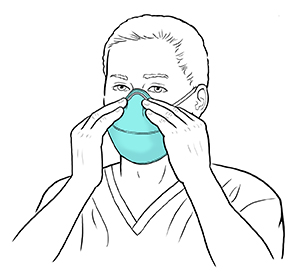Transmission-based precautions help prevent the spread of certain infections. Airborne precautions are 1 type of transmission-based precaution. Transmission-based precautions are used in addition to the standard precautions for infection control.
When to use airborne precautions
Some germs can float through the air on tiny particles. They can stay in the air for a long time and travel long distances. Use airborne precautions with patients known or suspected to be infected with any of the following:
-
Active tuberculosis
-
Measles
-
Varicella (chickenpox) or wherever a patient has a vesicular rash of unknown origin
-
Ebola
-
Severe acute respiratory syndrome (SARS)
-
Severe acute respiratory syndrome coronavirus 2 (SARS-CoV-2; COVID-19)
How to use airborne precautions
The patient should be placed in a private room with a private bathroom and special air handling. If this can’t be done, check with your facility’s infection control department. Also:
-
Wear approved respiratory protection when in the patient’s room if the patient is suspected of having any infection that can be transmitted through air.
-
Put on respiratory protection (NIOSH-approved N95 or higher respirator) before entering a restricted room. Take it off only after leaving the room. Visitors must also wear protection.
-
If there is the possibility of respiratory fluids being sprayed, wear a gown, gloves, and goggles or face shield.
-
Perform meticulous hand hygiene before and after coming into contact with the patient, the patient's respiratory secretions or body fluids, or contaminated items.
-
Change your face mask if it becomes soiled. Dispose of it in a plastic bag and then in the trash.
-
Keep the room’s doors and windows closed at all times.
-
Allow only essential people (as defined by your facility) to enter the room.
-
Choose disposable or specifically assigned equipment for patient care.
-
In situations where using equipment for multiple patients is necessary, make sure to thoroughly clean and disinfect the equipment before using it on a different patient.
-
Teach the patient to cough and sneeze into tissues and dispose of them correctly.
-
Transport the patient only when you absolutely must. Have the patient wear a correct mask and practice respiratory hygiene. Alert the receiving department.
Protecting yourself with a respirator
-
Wear the respirator approved by your facility.
-
Ask whether the respirator needs to be fit-tested before you first wear it. This test makes sure that the respirator mask fits right.
-
Check the fit of the respirator every time you put it on. You will be shown how to do a fit check.
-
Put the respirator on before entering a restricted room. Take it off only after leaving the room.
-
Each respirator should be used by one person only and should not be shared.


